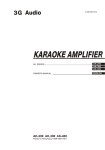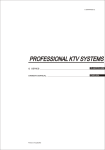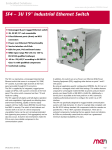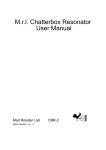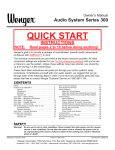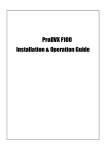Download DuaLFO Installation and User Manual
Transcript
CESYG DUALFO USER MANUAL CESYG DuaLFO Installation and User Manual Document CE-101-0002A Page 1 CESYG DUALFO USER MANUAL DUALFO Installation and User Manual Copyright © 2012 Neil Johnson First edition, May 2012 Revised, October 2012 All rights reserved. No part of this publication may be reproduced, stored in a retrieval system, or transmitted, in any form or by any means, electronic, mechanical, photocopying, recording, or otherwise, without the prior written permission of the author. CESYG Web: http://www.cesyg.com Email: [email protected] Page 2 CESYG DUALFO USER MANUAL Make beautiful sound Page 3 CESYG DUALFO USER MANUAL Page 4 CESYG DUALFO USER MANUAL Contents 1. INTRODUCTION Special Features 2. SPECIFICATION 3. INSTALLATION Unpacking Installing the Power Cable Main LFO Normalising Options Installing the DUALFO Power-on Test 4. ADJUSTMENTS Shape Maximum Bias Trim (VR1) Sine Shape Trim (VR2) 5. USING THE MAIN LFO Output waveforms Controls Applications 6. USING THE AUXILIARY LFO Output waveforms Controls Applications 7. NOTES 8. WARRANTY AND SERVICE Service History Page 5 7 8 9 11 11 11 13 13 14 15 15 15 17 17 17 18 21 21 21 23 27 31 32 CESYG DUALFO USER MANUAL Page 6 CESYG DUALFO USER MANUAL 1. INTRODUCTION This manual describes the installation and operation of the CESYG DUALFO two-channel low-frequency oscillator (LFO) for the Eurorack modular synthesizer system. Main 0° Out Main LFO CV In Main 120° Out Aux LFO Sync In Main 240° Out Aux LFO CV In Aux Tri Out Aux LFO Shape In Aux Sine Out Page 7 CESYG DUALFO USER MANUAL Special Features The DUALFO has been designed and constructed with care and attention to detail: - The SYNC edge switch is a high-quality ALPS SPUN push switch, the same type as commonly found in many mid-range British audio mixing consoles (maybe not Neve or SSL, but definitely Allen+Heath, SoundCraft, and SoundTracs). - A Dual Earth system, similar to that employed by MOTM and Oakley, is used to separate the internal power and signal ground from the front panel and jack ground. This helps keep the noisy external ground away from the internal ground while remaining completely compatible with existing Euro modular power systems. - Robust power input protection. Series Schottky diodes only permit current flow in the normal safe direction. If the power cable is fitted backwards, no current flows. This is in contrast to some Euro modules that use reverse diodes and series resistors, where during a fault the diodes conduct the full power supply current through the low-values resistors until you notice a burning smell and/or smoke before turning the power off! Or other Euro modules that have no protection whatsoever. - Designed for maintenance. Signal jacks suffer a lot of mechanical stresses. In the DUALFO all jacks are mounted on easily removable jack boards. All pots are standard 16mm commercial types (e.g., Alpha, Alps, BI Technologies, etc) so when they eventually fail spares should be widely available wherever you are. - All inputs are nominally 51kOhm to minimise loading of signal sources, with special input circuitry designed to minimise changes of input impedance over the full input control range. - High quality double-sided FR4 fibre-glass PCB, through-hole plated with solder mask and silk screen legend, tin-plated, and assembled using lead-free components and leadfree solder throughout to comply with the European RoHS directive. Page 8 CESYG DUALFO USER MANUAL 2. SPECIFICATION Main Oscillator Frequency range: Approx. 200uHz (approx. 90 minutes) to 45Hz Outputs Waveforms: Three phase-related sinewaves at 0°, 120°, 240° Level: 10Vp-p output centered about 0V (typ. +/-5V) Impedance: 1kOhm Indication: Red/green bi-colour LED showing 120° sinewave Inputs: CV (impedance: 51kOhm) Controls: Manual frequency control, log scale External CV control of frequency with unipolar attenuator, linkselectable normalised to either auxiliary sine wave output or bus CV. Auxiliary Oscillator Frequency range: Approx. 200uHz (approx. 90 minutes) to 45Hz Output Waveforms: Triangle, sine, both variable shape (see below) Level: 10Vp-p output centered about 0V (typ. +/-5V) Impedance: 1kOhm Indication: Red/green bi-colour LED showing triangle wave Inputs: CV (impedance: 51kOhm) Sync (impedance: 51kOhm) Shape (impedance: 51kOhm) Page 9 CESYG DUALFO USER MANUAL Controls: Shape: Manual frequency control, log scale External CV control of frequency, with unipolar attenuator External sync input, with switchable positive or negative edge sensitivity Manual control over 10% to 90% range, centre 50%. External shape modulation over the range -5V to +5V, manual control operates as bipolar attenuator (left = negative, right = positive). Power Input: +/-12V to +/-15V, 40-50mA per rail Connector: Eurorack standard 16-pin power/bus connector Protection: Reverse voltage protected, missing rail protected Ground: Dual Earth grounding system, compatible with all Euro power systems Mechanical Panel size: 18HP Euro format, 128.40mm x 91.10mm Panel material: 2mm Anodised Aluminium Depth behind panel: 100mm Note: As this is an analogue device specifications are subject to minor variations between devices. Page 10 CESYG DUALFO USER MANUAL 3. INSTALLATION Fitting the DUALFO into your modular synthesizer is a straightforward task. This section describes the basic steps in unpacking and installing your DUALFO and a first initial power-on test. Unpacking The DUALFO comes packed in anti-static packaging. Do not open the packaging until you are ready to install the module in your modular synthesizer. As well as the DUALFO you should find this manual, a 16-way power cable, and a bag of M3x6mm screws. Make sure you have a space of at least 18HP (91mm) in your rack unit, and one spare power connection. Installing the Power Cable The DUALFO is fitted with a standard 16-pin power header and supplied with a power cable. If your power distributor is 10-way then will need a special 10/16-way adaptor cable. These are available from many sources online. Disconnect power from your synthesizer. It is recommended to remove the AC power cable from the wall socket. Fit one end of the module power cable to the DC distribution board in your synthesizer. Leave the other end trailing out of the case. Page 11 CESYG DUALFO USER MANUAL Hold the DUALFO in one hand and insert the other end of the power cable into the power socket on the DUALFO, located at the bottom edge of the rear of the PCB. Both the header and the connector are polarised to ensure that they can only mate one way. As a guide, note that the RED stripe of the cable aligns with the marks on the PCB: Page 12 CESYG DUALFO USER MANUAL Main LFO Normalising Options Before fitting the DUALFO into your synthesizer there is an on-board link option. This sets the source of the normalised CV input of the main oscillator. The default position sets the source to the sine wave output of the auxiliary oscillator. You can change the link to select the CV line on the power bus. The link is located just above the power connector: Installing the DUALFO Now fit the DUALFO into your synthesizer. Carefully slide the module into the case, making sure the power cable is not caught on anything. Offer up the DUALFO panel to Page 13 CESYG DUALFO USER MANUAL the frame and fit the four M3 screws supplied to hold the DUALFO in place. Tighten the screws, but do not over tighten them. The recommended torque is 1.0Nm. Note: if your rack rails are made to accept M2.5 screws you must either supply them yourself, or they were provided with your DUALFO as a special option, or you can purchase them either from CESYG or elsewhere. Power-on Test Refit the AC power cable to your synthesizer. Set the DUALFO Freq controls to maximum, set the CV controls to minimum, and the Shape control to midway; the Sync button can be in or out. Turn on power. Both oscillator LEDs should be flashing red/green - they should be visibly flickering. This concludes the installation. Page 14 CESYG DUALFO USER MANUAL 4. ADJUSTMENTS There are two adjustments on the DUALFO, both related to the Auxiliary LFO. Shape Maximum Bias Trim (VR1) The maximum range of the effect of the Shape control can be adjusted. During assembly this is set to approximately 10% to 90%. Sine Shape Trim (VR2) The Auxiliary sine wave output is derived from the triangle waveform using a diode shaper. VR2 can be used to fine-tune the shape of the sine wave to minimise distortion. Normally this is done during assembly, but if the unit is subject to excessive mechanical shock or to a repair to the auxiliary LFO then it may be necessary to re-adjust VR2 to achieve the optimum sine wave shape. While it can be done with only an oscilloscope, it is recommended that an audio distortion analyzer is used if available. The auxiliary LFO should comfortably achieve sine wave THD of around 1.5%. Page 15 CESYG DUALFO USER MANUAL Page 16 CESYG DUALFO USER MANUAL 5. USING THE MAIN LFO The Main LFO provides three sine wave signals, ideal for providing spatial modulation or pseudo-stereo effects. Or, together with a 2-channel mixer, you can generate two sine waves with any phase offset you require in the range 0 to 360 degrees. Output waveforms Each of the three outputs of the Main LFO is a low-distortion sinewave. The three outputs are at fixed phase offsets of 0, 120 and 240 degrees. Controls The Main LFO has two controls and one external control input. FREQ The FREQ control provides manual control of the frequency of the Main LFO. With the control turned fully anti-clockwise the frequency is at its minimum; turned fully clockwise the frequency is at maximum. CV The CV control determines how much of the signal fed to the CV jack is used to modulate the Main LFO frequency. The control provides a linear scale, from 0% (fully anti-clockwise) to 100% (fully clockwise). Page 17 CESYG DUALFO USER MANUAL The CV jack is normalised to one of two internal signals: the internal bus CV or the Auxiliary LFO sine wave. When no jack is inserted into the CV socket then the normalised signal is fed into the CV input and treated in exactly the same way. Applications The three outputs of the Main LFO can be used separately - for example, to generate pseudo-stereo rotation - or combined to generate a sine wave of any desired phase offset. 3D Panning Connect each output to a VCA, with all three VCAs fed from the same audio source. Now send each VCA’s output to a separate amplifier and speaker, arranged at equidistant points around a circle. Place yourself in the middle of the circuit, and the result will be a sound that rotates around you! Swap over two of the sine outputs to change the direction of rotation. Arbitrary Phase Sine Wave A sine wave of any arbitrary phase offset can be generated from some combination of three equally-spaced sine waves. This is easy to achieve with the DuaLFO and a two-input mixer. For your convenience a phase diagram is given at the end of this manual. For example, suppose you want two sine waves with a 90 degree phase offset between them (this is often called quadrature). Let the first sine wave be the topmost output jack of the Main LFO - the 0 degree output. Page 18 CESYG DUALFO USER MANUAL Now take a look at the phase diagram (end of manual). An arrow at the 90 degree position lies between the 0 degree and 120 degree arrows, so we need some mix of these two sine waves to produce the required 90 degree one. As the 90 degree arrow is closest to the 120 degree arrow we start with 100% of the 120 degree sine wave. Then, note that the 90 degree arrow crosses the dashed horizontal line - this corresponds to the 0 degree sine wave. As it crosses the middle this shows that we need half, or 50%, mix of the 0 degree sine wave. Finally, also see that the length of the arrow from the centre to where it crosses the dashed line is about 87% of the full length. This tells you the amplitude of the result: about 87% of the full scale signal (about +/- 4.3V). If all this sounds complicated, it really isn’t! Try it for yourself with a pencil and ruler. After a couple of minutes you will soon master this technique! And then you will be able to synthesize two sine waves with any phase offset you want. You could also use three VCAs (e.g., three-channel VCA mixer) so that the synthesized sine wave is under full voltage control. Video Synthesis With three phase-locked outputs the main LFO is ideal for modulating the red, green and blue components in video synthesis. The auxiliary LFO can then be used to modulate the main LFO to introduce further colourful modulations, perhaps synchronised to some visual trigger or some multiple of the frame period. Page 19 CESYG DUALFO USER MANUAL Page 20 CESYG DUALFO USER MANUAL 6. USING THE AUXILIARY LFO The Auxiliary LFO complements the multiple outputs of the Main LFO with a much greater degree of control over the shape and behaviour of its single output. Output waveforms The Auxiliary LFO internally generates a very precise triangle wave. This is provided as one of the two outputs. The second output is a diode-shaped sine wave, with distortion below 2%. The shape of the triangle wave (and also the sine wave) can be modulated internally or externally. Controls The Auxiliary LFO has four controls comprising three pots and one push switch. FREQUENCY The FREQ control provides manual control of the Auxiliary LFO’s frequency. With the control turned fully anti-clockwise the frequency is at its minimum; turned fully clockwise the frequency is at maximum. Page 21 CESYG DUALFO USER MANUAL CV The CV control determines how much of the signal fed to the CV jack is used to modulate the Auxiliary LFO frequency. The control provides a linear scale, from 0% (fully anti-clockwise) to 100% (fully clockwise). SYNC The Sync input can be used to synchronise the Auxiliary LFO to an external trigger signal. The push button allows you to choose whether to synchronise to the rising (positive) or falling (negative) edge of the trigger signal. Examples of trigger signals include clocks, gates, keyboard triggers, square/pulse waves, and so on. You can even use the reset edge of a sawtooth or ramp waveform as long as the sync edge switch is set to the corresponding input signal edge. SHAPE The Shape control provides manual control of the shape of the triangle wave. When set to to the mid position the Auxiliary LFO generates a triangle wave. With the control turned to the left the duration of the rising (left) edge of the triangle is shortened, and vice versa for the other direction. One way to imagine this to think of the triangle falling over to the left or the right. At the extreme ends of the control the triangle wave looks more like a sawtooth or ramp wave form. If a jack is inserted into the Shape socket then an external voltage can be used to vary the shape of the triangle. In this mode of operation the Shape control becomes an inverting attenuator: with the control in the middle position the external voltage has no effect on the shape; when turned left the external voltage directly modulates the shape; when turned right the external voltage is inverted and then used to modulate the shape. For the technically-minded, the Shape socket is normalised to +5V. Page 22 CESYG DUALFO USER MANUAL Applications The Auxiliary LFO is a versatile modulation source. Main LFO Modulation Source The natural use of the Auxiliary LFO is to provide frequency modulation for the Main LFO. This is made through the optional internal normalising from the Auxiliary sine wave output to the Main CV input. The Shape control then comes into play to vary the profile of the frequency modulation of the Main LFO, with dramatic full sweeps with the Shape control at either extreme. Externally Synchronising The Auxiliary LFO One significant difference between the Main and Auxiliary LFOs is the Sync input. Put simply, the Sync input synchronises the Auxiliary LFO to an external trigger or clock signal. It is switchable between positive and negative edge sensitivity. When triggered, the Sync input forces the Auxiliary LFO to the start of its cycle (0 degrees). This is defined as being an output of 0 volts, and rising. The oscillograph on the next page shows the Auxiliary LFO sine wave output (top) being synchronised to the rising edge of an external square wave (bottom). The triangle output will follow a similar path, but with straight lines instead of the graceful curves of the sine. Page 23 CESYG DUALFO USER MANUAL Page 24 CESYG DUALFO USER MANUAL Slowly Evolving Sound Textures The slow rates that the Auxiliary LFO can achieve make it useful for creating slowly evolving sound textures. Parameters that could be modulated to varying depths include VCO detuning or unison (multiple VCO) spreading, stereo or 3D panning, filter cutoffs, and so on. In addition, synchronising the Auxiliary LFO to a start pulse will ensure repeatable performance results. Page 25 CESYG DUALFO USER MANUAL Page 26 CESYG DUALFO USER MANUAL 7. NOTES The pages in this section are intended for you to make your personal notes on operating the DUALFO. The diagram pages are intended for you to photocopy or scan and print so that you can record patch settings and phase diagrams. Page 27 CESYG DUALFO USER MANUAL PATCH SHEET Name: .............................................................................................. NOTES NOTES Page 28 CESYG DUALFO USER MANUAL Page 29 CESYG DUALFO USER MANUAL NOTES Page 30 CESYG DUALFO USER MANUAL 8. WARRANTY AND SERVICE Your DUALFO comes with a 12 month warranty from the date of first sale. If your DUALFO requires repairs resulting from a manufacturing defect you can return it in the first instance to the retailer you bought it from. Any damage caused by user negligence is not covered by this warranty. Such damage may include, but is not limited to, abusive usage, fluid spills, excessive voltages on inputs and/or outputs. Repairs for these types of damage will be charged at usual service rates. The terms of this warranty do not affect your statutory rights. For all technical enquiries please use the following email address for all correspondence: help @cesyg.com The following page is to be used for recording any and all servicing, repairs, and modifications made to your DUALFO. Page 31 CESYG DUALFO USER MANUAL Service History Date Technician Details ........................ ......................... ............................................................................................................................. ........................ ......................... ............................................................................................................................. ........................ ......................... ............................................................................................................................. ........................ ......................... ............................................................................................................................. ........................ ......................... ............................................................................................................................. ........................ ......................... ............................................................................................................................. ........................ ......................... ............................................................................................................................. ........................ ......................... ............................................................................................................................. ........................ ......................... ............................................................................................................................. ........................ ......................... ............................................................................................................................. ........................ ......................... ............................................................................................................................. ........................ ......................... ............................................................................................................................. ........................ ......................... ............................................................................................................................. ........................ ......................... ............................................................................................................................. ........................ ......................... ............................................................................................................................. Page 32
































